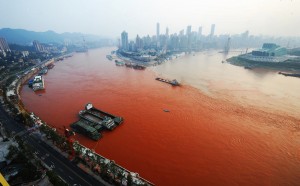
A stretch of China’s mighty Yangtze River, near the city of Chongqing, has turned an alarming shade of red (International Business Times).
The cause of the colouring is still unclear. “One possible cause of the colouration may be suspended sediments, following heavy rains upstream”, says Hans Paerl, a marine and environmental scientist at the University of North Carolina in Chapel Hill. “This is common in large river systems such as the Yangtze, and southern China has had large rainfall events this summer,” he says.
Indeed, on 7 September the Chongqing Environmental Protection Agency noted on its website that a water-quality monitoring centre on the Yangtze had detected very high concentrations of silt in the river. The agency says that torrential rain in the upper Sichuan province caused huge amounts of silt to wash into the Yangtze. It also says that the water does not contain hazardous or noxious substances.
Scientists interviewed by Nature say that it is unlikely, although not impossible, that the colouring is a result of an algal bloom. Sudden growths of algae, fed by fertilizer run-off (a process known as eutrophication), can sometimes produce blooms of brownish diatom algae in rivers, says Sergi Sabater, a limnologist at the Catalan Institute of Water Research in Spain, who carries out research in river ecology. Such ‘red tides’ of algae are sometimes observed in warm, shallow and nutrient-rich seas. But in this case, “if it is a eutrophication event, then it is enormous”, says John Dearing, a physical geographer at the University of Southampton, UK, who has done research into the eutrophication of lakes on the lower Yangtze.
Dearing also notes that in December 2011, the Jian River in northern China turned red after dye pollution leaked into the river from a factory. “Cases of dye pollution are very, very common in China,” he says.
The 1.8-million-square-kilometre Yangtze basin constitutes 18.8% of China’s land area and accounts for 36.5% of China’s available fresh water, according to the ChangJiang Water Resources Commission (CWRC), the river basin authority.
According to a 2007 WWF report, it is among the world’s top ten rivers at risk of serious pollution. In May 2011, China’s state council admitted that the river ecosystem could potentially be harmed by the Three Gorges Dam, located in the Hubei province, downstream of Chongqing (New York Times).
http://www.nature.com/
Δεν υπάρχουν σχόλια:
Δημοσίευση σχολίου